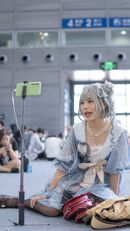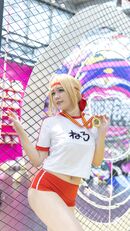| This page needs work. Please help us by expanding it. If you aren't sure how to help, check the article guide Format and Content Reason: This page is under construction. |
Reason for Warning: Though this page doesn't go into detail about it, brief mentions of sexual elements are brought up.
Weeaboo (not to be confused with Otaku) is a term associated with western (or otherwise outside of Japan) fans of anime, and the culture surrounding them. This word has taken on many different meanings and connotations throughout the years, making the meaning of it in specific instances highly contextual; however, it is all centered around a western love of anime and/or Japanese culture, with the variant being how this love is viewed/expressed.
Being a weeaboo can be expressed as a subculture. Other than media consumption, weeaboos may also attend anime conventions, follow social media artists, and learn about Japanese daily living. While it began as a niche community with "loser" connotations, the growing accessibility of anime in the west has made this community more well-known and popular, with some interpretations being "cooler".
The different connotations of Weeaboo can be seen represented in the current split of the term between Weeaboo and Weeb. However, the word has a negative connotation, with the implication that the weeaboo is not knowledgeable of real Japan and is more so infatuated with the rose-tinted-glasses version presented through popular culture.
History[]
Etymology[]
The current term Weeaboo is only just the modern iteration of a term for western lovers of Japanese culture/media. The first recognizable instance of such a term came from the 18th century, and was called Japanophile.[1] It should be noted though that this sort of term was not exclusive for Japan, as there are many similar terms such as Anglophile, Germanophile, and Ailurophile. These terms are used for a person with a love and appreciation for a specific culture, though the context and connotation varies term to term.
The first instance of a term resembling the modern iteration came around 2000 from the site 4chan, where the term Wapanese caught traction as a derogatory term for those obsessed with Japan on the site.[2]
Around 2005, the moderators of 4chan created a word-filter that actively replaced each instance of Wapanese with Weeaboo.[3] Weeaboo, first seen in a comic by Nicholas Gurewitch, was meant to be a meaningless word. However, the filter was ineffective as 4chan users began using this word as a replacement for Wapanese and the meaning simply transferred over.[2]
Since then, the term has been shortened to Weeb, though it would be wrong to say definitively that the two versions of the term share the same meaning.
Visuals[]
This page is under construction
One of the most common motifs in anime is the use of anime girls, who are visually attractive characters from anime or drawn for arts' sake that could be either Moe, meaning cute and inspiring protection, or Ecchi, which is a sexually explicit depiction. There are certain tropes associated with these two types. With Moe, their eyes are typically enlarged and they appear explicitly childlike. Maid, Lolita, and generally childlike or Kawaii fashion is more popular with Moe. Meanwhile, Ecchi characters are half-nude, with skimpier maid uniforms, bikinis, etc. In anime, extremely large breasts are popular and are a common association with Weeb culture.
Specific female characters also became incredibly popular and are used as memes. Examples include the VOCALOID Hatsune Miku, Chika Fujiwara from Kaguya-Sama Love is War, Rei and Asuka from Neon Genesis Evangelion, Rem from RE:Zero, and more. Anime girls who inspire large amounts of dedication are called waifus.
The above is typically a heterosexual male aspect of the hobby. With some female anime fans, being a fujoshi is a similarly odd and sexual component. This word describes women who are attracted to homosexual male relationships in anime and manga, with their interest being fetishistic. Like the above, certain characters are the male counterpart to waifus, called husbandos. Being slim, having a mysterious or "cool" aura, and working as butlers or class presidents are some common tropes. However, they are not as meme-ified as the female characters.
Waifus, husbandos, and anime characters in general are incorporated into real-life visual culture through being put on stickers, posters, anime figurines, plushies, body pillows, tee shirts, and even on cars. These products are sold by the company that produced the anime and fan artists. Dedicated stores exist, but many people buy these things at anime conventions.
Anime conventions themselves have an expected layout and series of events that can be highly visual.
Additionally, incredibly large manga collections are a status symbol. Weeaboo rooms are often the visual indicating obsession with the large collection of objects.
Because of the fascination with Japan, it is also common for weeaboos to own things that are not necessarily anime-related, but also Japan-related. This often crosses over with Mall Ninja, as certain weeaboos have an idealized image of Japanese weaponry and would own katanas, shuriken, etc.
Another aspect of Weeaboo fascination with Japan is the Kawaii culture and alternative fashions available there. For more information, see the fashion portion below and the links to the pages.
Weeaboos may also express their admiration for Japan through food. Ramen, bento boxes (especially modeled after anime), and sushi are some stereotypical foods that are often meme-ified and made to be plushies and fetishized. A common stereotype of weeaboos is that they would express snobbery about Japanese food practices, but not being realistic of the fact that they are eating it in a Western country. Japanese junk food and snacks, such as Pocky, Calbee chips, Ramune soda, and instant ramen are also popular, with many subscription services existing to cater to this.
- Anime photo/video edits
- Aesthetic edits of an anime character
- Anime AMVs
- Anime character edits with hearts
- Fan art/ship art
- An e-girl/boy-esque style, with more of an anime/'kawaii' twist
- More pastel
- Anime references on clothes
- Anime-inspired make-up
- Pastels
- Japanese writing
- Stuffed animals/toys
- Bangs
- Half-dyed hair
- Heart edits on pictures
- Emoticons such as ":3" and "owo"
- Ahegao faces
- Anime phone screens
- Manga collections
- Anime character phone cases
- Anime/Japanese-themed T-shirts
- Pigtails
- Decorated backpacks and folders
- Boba tea
Fashion[]
Weeaboo fashion revolves around wearing merchandise of anime, or trying to emulate the look of an anime character through cosplay:
- Anime graphic tops and bottoms
- Sailor uniforms
- Maid dresses
- Pleated skirts
- Layered tulle skirts
- Loose leg warmers
- Printed thigh highs
- Platform shoes
- Plush animal ears
- Colorful hairpins
- Scrunchies with kawaii motifs
- Kandi featuring anime themes
- Itabags
- Circle lens
- Big eye makeup
- Anime-style blush
- Otherwise wearable anime merch (necklaces, badges, keychains, etc)
- Lots of accessories
- Cat ear headphones, headbands, and clip-ons
- Fake cat whiskers
- Body blush
- Long socks, often striped or loose
- Nanchatte Seifuku
- Harajuku-inspired fashion
- Cosplay pieces, usually worn with everyday outfits
- Anime pins
- Eye patches
- Fake scars
- Unnecessary bandages/Band-Aids
- Wigs
- Glasses
- Makeup
Vendors[]
- Animelife
- Bakuretsu
- Catori Clothing
- HVY BLK
- Imouri
- In Control Clothing
- Invasion Club
- Omocat
- Solid Line
- Steady Hands
Weeaboo[]
Weeaboo, despite its variability, is most commonly used as a derogatory term describing a person who is overly obsessive with Japanese culture and medium, to the point where it effects their personality, mannerisms, and daily life.
This term is commonly associated with younger people, usually in middle school or early high-school, though it can be used for anyone regardless of age.
The word is often shortened to Weeb. As with Weeaboo, the meaning of the term is highly contextual. While it is still used derogatory, the general use of the term tends to be either ironic, or used to refer to someone who simply enjoys Japanese culture and/or media, but as no obsession with it or use of it as a personality trait.
Culture[]
Discussing the culture is, once again, highly contextual; for this reason, this page will just be discussing key notes and staples of the culture without differentiating between the use or association (i.e., ironic, genuine, self-aware, mild, Weeb, Weeaboo, etc.). This will just be a focus on the general aesthetic of the culture, and its known aspects.
The culture revolves around mostly anime, manga, and Japanese fashion. As stated before, it is stereotypically an obsession with Japanese culture portrayed through the lens of a westerner whose only real view of Japan is through anime and other similar mediums.
Key aspects are:
- The adoption of select Japanese words in English conversation, such as "kawaii", "sugoi", and "desu"
- A perception of the culture being a major aspect of "cringey" internet culture
- Use of stylistic text/communication mannerisms such as "OwO" and "Rawr"
- A "Kawaii" fashion aesthetic as well as a general adoption of it
- Talking in either a higher or lower voice, as if mimicking anime voice acting
- The "Naruto run"
- Cosplay
- Waifus/Husbandos
- Body pillows
- Roleplay
- Cat ears
- Buttons, stickers, printed out pictures, and anything else associated with a weeaboo's fandoms being overused and put everywhere








































